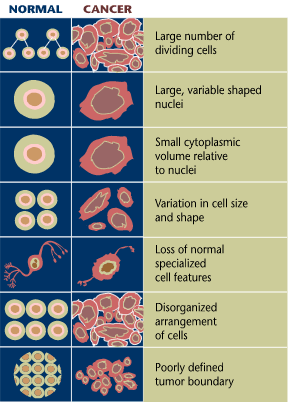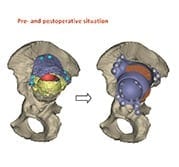
A team of researchers from five Swedish universities have made a remarkable breakthrough in the treatment of cancer, with an equally innovative source of funding.
Led by Karolinska Institutet and the Science for Life Laboratory in Stockholm, the team has made inhibitors that kill cancer cells but not normal cells.
“We are first to show this new way of targeting cancer and this is likely going to be the major path for drug development in the future,” said Thomas Helleday, holder of the Söderberg Professorship at Karolinska Institutet, who heads the study.
Until now, most modern anti-cancer drugs have been tailored to target the genetic makeup of the cancer – a so-called personalized treatment. Sometimes this can have a long-lasting effect, but more often than not the cancers mutate to become resistant. What the team has managed to do is to target an enzyme that is required for all cancer cells for survival, but that normal cells do not need.
Helleday explained that the treatment – which comes in the form of a pill – can kill any cancer and does not have any severe side effects.
“Some say our finding sounds too good to be true, and I understand their gut feeling after seeing so many promising cancer treatments fail,” he said. “My research group has made paradigm shifts before and to those skeptics I say: just sit back and enjoy the revolution!”
What’s also revolutionary is the way the research is financed, through “open innovation” and “crowd sourcing”.
“I started a public foundation that owns all intellectual property and the idea is that we manufacture large amounts of the drug and provide it for free to the worldwide academic community, so they can design their own clinical trials and run them”, Helleday said.
“Also, as there is a public foundation behind the drug, it will not be used to enrich a few individuals, but be used for further work on new medicines.”
A lot of work remains to be done before it is time for clinical trials, which are still a year or two away, Helleday said.
Being based in Stockholm brings many advantages, including a number of highly trained drug developers looking for new challenges, he said.
“A major point is that Swedish Universities do not claim or take control on intellectual property, allowing us to donate it to a public foundation,” Helleday said.
“Another advantage is the collaborative nature of Swedes. We collaborated with five different universities to progress the project, which would have been difficult elsewhere.”
Their concept is presented in two articles in science journal Nature, with the aim of spreading the word to as many as possible in the research community.
“It has generated interest from academics across the world, to try the new concept on the cancer indication they have specialized in,” Helleday said.
The team has also sent out the compound to hundreds of scientists across the globe in an effort to increase the speed of innovation and to reach the goal of curing cancer more quickly. By freely sending out compounds, they have increased competition.
“Hundreds of scientists are advancing more quickly than one and we increase the chances of overall success,” Helleday said.
The Latest on: Cancer breakthrough
[google_news title=”” keyword=”Cancer breakthrough” num_posts=”10″ blurb_length=”0″ show_thumb=”left”]
via Google News
The Latest on: Cancer breakthrough
- AI breakthrough from Google’s DeepMind could revolutionise biologyon May 9, 2024 at 5:23 am
Google’s artificial intelligence division DeepMind has unveiled a new model that researchers claim could revolutionise biology and lead to breakthroughs in everything from cancer treatments to crop ...
- Epredia’s SlideMate™ Laser Printer Named “Best New Technology Solution for Pathology” in 2024 MedTech Breakthrough Awards Programon May 9, 2024 at 3:00 am
LOS ANGELES, May 09, 2024 (GLOBE NEWSWIRE) -- MedTech Breakthrough, an independent market intelligence organization that recognizes the top companies, technologies and products in the global digital ...
- Supercharging immune cells to battle blood cancer: breakthrough in cancer immunotherapyon May 8, 2024 at 10:42 pm
A new study reveals a groundbreaking approach to immunotherapy, demonstrating that blocking the interaction between the CD300A receptor and ...
- Breakthrough in robotic surgery for breast cancer; minimal invasive tech used in Karnatakaon May 8, 2024 at 2:34 pm
Bengaluru: With robotic surgery advancing by leaps and bounds, cancer specialists have adopted various robotic tools to improve accuracy and efficiency, making surgeries minimally invasive to achieve ...
- Google DeepMind’s latest medical breakthrough borrows a trick from AI image generatorson May 8, 2024 at 12:48 pm
Much of the recent AI hype train has centered around mesmerizing digital content and the potentially dangerous ways it could disrupt society. But on the brighter side, an update to Google’s AlphaFold ...
- Groundbreaking at-home cervical cancer test granted 'breakthrough' status by FDA, fast-tracking approval processon May 8, 2024 at 5:30 am
Teal Health's at-home cervical cancer test just received 'Breakthrough Device' status by the FDA, in hopes of significantly reducing cervical cancer rates in the U.S.
- The cancer revolution: Eight game-changing breakthroughs which show just how close we are to a cureon May 7, 2024 at 5:00 pm
Figures from 2020 show that more than 75 per cent of people with cancer survived at least one year after diagnosis. And thanks to astonishing scientific breakthroughs, things will only get better. As ...
- Unlocking the immune system: cGAS-STING pathway offers new hope for cancer breakthroughson May 2, 2024 at 5:00 pm
A groundbreaking study has recognized the cGAS-STING signaling pathway as a formidable ally in the immune system's battle against cancer.
- Cancer breakthrough could mean 'personalised' treatmentson May 1, 2024 at 5:00 pm
Scientists have found that some immune cells hunt down cancer in the body, a discovery that could lead to personalised treatments for advanced breast cancer. The study identified features of cells ...
- Prostate Cancer Breakthrough: Urine Test Avoids Unnecessary Biopsieson April 28, 2024 at 9:57 pm
A study in JAMA Oncology reveals that MyProstateScore 2.0, a new urine test analyzing 18 genes, surpasses PSA in detecting significant prostate cancers and could reduce unnecessary biopsies by up to ...
via Bing News










